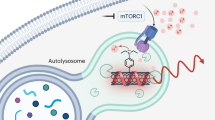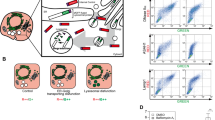Abstract
Autophagy is a catabolic process involved in the degradation and recycling of long-lived proteins and damaged organelles for maintenance of cellular homeostasis, and it has also been proposed as a type II cell death pathway. The cytoplasmic components targeted for catabolism are enclosed in a double-membrane autophagosome that merges with lysosomes, to form autophagosomes, and are finally degraded by lysosomal enzymes. There is substantial evidence that several nanomaterials can cause autophagy and lysosomal dysfunction, either by prevention of autophagolysosome formation, biopersistence or inhibition of lysosomal enzymes. Such effects have emerged as a potential mechanism of cellular toxicity, which is also associated with various pathological conditions. In this chapter, we describe a method to monitor autophagy by fusion of the modifier protein MAP LC3 with green fluorescent protein (GFP; GFP-LC3). This method enables imaging of autophagosome formation in real time by fluorescence microscopy without perturbing the MAP LC3 protein function and the process of autophagy. With the GFP-LC3 protein fusion construct, a longitudinal study of autophagy can be performed in cells after treatment with nanomaterials.
Access this chapter
Tax calculation will be finalised at checkout
Purchases are for personal use only
Similar content being viewed by others
References
Guimaraes RS, Delorme-Axford E, Klionsky DJ, Reggiori F (2015) Assays for the biochemical and ultrastructural measurement of selective and nonselective types of autophagy in the yeast Saccharomyces cerevisiae. Methods 75:141–150. doi:10.1016/j.ymeth.2014.11.023
The Nobel Prize in Physiology or Medicine 2016. Nobel Media AB 2014. http://www.nobelprize.org/nobel_prizes/medicine/laureates/2016/. Accessed 14 Oct 2016
Klionsky DJ, Emr SD (2000) Autophagy as a regulated pathway of cellular degradation. Science 290(5497):1717–1721
Johnson-Lyles DN, Peifley K, Lockett S, Neun BW, Hansen M, Clogston J, Stern ST, McNeil SE (2010) Fullerenol cytotoxicity in kidney cells is associated with cytoskeleton disruption, autophagic vacuole accumulation, and mitochondrial dysfunction. Toxicol Appl Pharmacol 248(3):249–258. doi:10.1016/j.taap.2010.08.008
Adiseshaiah PP, Clogston JD, McLeland CB, Rodriguez J, Potter TM, Neun BW, Skoczen SL, Shanmugavelandy SS, Kester M, Stern ST, McNeil SE (2013) Synergistic combination therapy with nanoliposomal C6-ceramide and vinblastine is associated with autophagy dysfunction in hepatocarcinoma and colorectal cancer models. Cancer Lett 337(2):254–265. doi:10.1016/j.canlet.2013.04.034
Stern ST, Adiseshaiah PP, Crist RM (2012) Autophagy and lysosomal dysfunction as emerging mechanisms of nanomaterial toxicity. Part Fibre Toxicol 9:20. doi:10.1186/1743-8977-9-20
McLeland CB, Rodriguez J, Stern ST (2011) Autophagy monitoring assay: qualitative analysis of MAP LC3-I to II conversion by immunoblot. Methods Mol Biol 697:199–206. doi:10.1007/978-1-60327-198-1_21
Melendez A, Levine B (2009) Autophagy in C. elegans. WormBook:1–26. doi:10.1895/wormbook.1.147.1
Potter TM, Stern ST (2011) Evaluation of cytotoxicity of nanoparticulate materials in porcine kidney cells and human hepatocarcinoma cells. Methods Mol Biol 697:157–165. doi:10.1007/978-1-60327-198-1_16
Acknowledgment
This project has been funded in whole or in part with Federal funds from the National Cancer Institute, National Institutes of Health, under Contract No. HHSN261200800001E. The content of this publication does not necessarily reflect the views or policies of the Department of Health and Human Services, nor does mention of trade names, commercial products, or organizations imply endorsement by the U.S. Government.
Author information
Authors and Affiliations
Corresponding author
Editor information
Editors and Affiliations
Rights and permissions
Copyright information
© 2018 Springer Science+Business Media LLC
About this protocol
Cite this protocol
Adiseshaiah, P.P., Skoczen, S.L., Rodriguez, J.C., Potter, T.M., Kota, K., Stern, S.T. (2018). Autophagy Monitoring Assay II: Imaging Autophagy Induction in LLC-PK1 Cells Using GFP-LC3 Protein Fusion Construct. In: McNeil, S. (eds) Characterization of Nanoparticles Intended for Drug Delivery. Methods in Molecular Biology, vol 1682. Humana Press, New York, NY. https://doi.org/10.1007/978-1-4939-7352-1_18
Download citation
DOI: https://doi.org/10.1007/978-1-4939-7352-1_18
Published:
Publisher Name: Humana Press, New York, NY
Print ISBN: 978-1-4939-7350-7
Online ISBN: 978-1-4939-7352-1
eBook Packages: Springer Protocols




